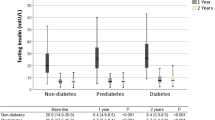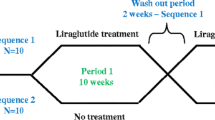Abstract
Aims
Microvascular dysfunction is a potential factor explaining the association of obesity, insulin resistance, and vascular damage in morbidly obese subjects. The purpose of the study was to evaluate possible determinants of microcirculatory improvement 1 year after laparoscopic sleeve gastrectomy (LSG) intervention.
Methods
Thirty-seven morbidly obese subjects eligible for bariatric surgery were included in the study. Post-occlusive reactive hyperemia (PORH) of the forearm skin was measured as area of hyperemia (AH) by laser-Doppler flowmetry before LSG and after a 1-year follow-up.
Results
After intervention, we observed a significant reduction in BMI, HOMA index, HbA1c, and a significant increase of AH in all patients after surgery; this variation was significant only in those patients having insulin resistance or prediabetes/diabetes. Although significant correlation between the increase of AH and the reduction of both BMI, HOMA index, and HbA1c was observed, BMI was the only independent predictor of AH variation after LSG at the linear regression analysis.
Conclusions
Our study shows that LSG intervention is correlated with a significant improvement in the microvascular function of morbidly obese subjects; this improvement seems to be related to the baseline degree of insulin-resistance and to the retrieval of insulin-sensitivity post-intervention.


Similar content being viewed by others
References
Whitlock G, Lewington S, Sherliker P, et al. Prospective studies collaboration. Body-mass index and cause-specific mortality in 900 000 adults: collaborative analyses of 57 prospective studies. Lancet. 2009;373(9669):1083–96.
Singer G, Granger DN. Inflammatory response underlying the microvascular dysfunction associated with obesity and insulin resistance. Microcirculation. 2007l;14(4–5):375–87.
Stapleton PA, James ME, Goodwill AG, et al. Obesity and vascular dysfunction. Pathophysiology. 2008;15(2):79–89.
Jonk AM, Houben AJ, de Jongh RT, et al. Microvascular dysfunction in obesity: a potential mechanism in the pathogenesis of obesity-associated insulin resistance and hypertension. Physiology (Bethesda). 2007;22:252–60.
de Jongh RT, Serné EH, Ijzerman RG, et al. Impaired microvascular function in obesity: implications for obesity-associated microangiopathy, hypertension, and insulin resistance. Circulation. 2004;109(21):2529–35.
Clark MG. Impaired microvascular perfusion: a consequence of vascular dysfunction and a potential cause of insulin resistance in muscle. Am J Physiol Endocrinol Metab. 2008;295(4):E732–50.
Stewart J, Kohen A, Brouder D, et al. Noninvasive interrogation of microvasculature for signs of endothelial dysfunction in patients with chronic renal failure. Am J Physiol Heart Circ Physiol. 2004;287(6):H2687–96.
Deanfield J, Donald A, Ferri C, et al. Working group on endothelin and endothelial factors of the European Society of Hypertension. Part I: methodological issues for assessment in the different vascular beds: a statement by the working group on endothelin and endothelial factors of the European Society of Hypertension. J Hypertens. 2005;23(1):7–17.
Stiefel P, Moreno-Luna R, Vallejo-Vaz A, et al. Which parameter is better to define endothelial dysfunction in a test of postocclusive hyperemia measured by laser-Doppler flowmetry? Coron Artery Dis. 2012;23(1):57–61.
Roustit M, Cracowski J. Non-invasive assessment of skin microvascular function in humans: an insight into methods. Microcirculation. 2012;19(1):47–64.
Kvandal P, Stefanovska A, Veber M, et al. Regulation of human cutaneous circulation evaluated by laser Doppler flowmetry, iontophoresis, and spectral analysis: importance of nitric oxide and prostaglandines. Microvasc Res. 2003;65(3):160–71.
Sjöström L. Review of the key results from the Swedish obese subjects (SOS) trial—a prospective controlled intervention study of bariatric surgery. J Intern Med. 2013;273(3):219–34.
Sjöström L, Peltonen M, Jacobson P, et al. Wedel et al. bariatric surgery and long- term cardiovascular events. JAMA. 2012;307(1):56–65.
Cornier MA, Marshall JA, Hill JO, et al. Prevention of overweight/obesity as a strategy to optimize cardiovascular health. Circulation. 2011;124(7):840–50.
Carlsson LM, Sjöholm K, Karlsson C, et al. Long-term incidence of microvascular disease after bariatric surgery or usual care in patients with obesity, stratified by baseline glycaemic status: a post-hoc analysis of participants from the Swedish obese subjects study. Lancet Diabetes Endocrinol. 2017;5(4):271–9.
Rossi M, Nannipieri M, Anselmino M, et al. Skin vasodilator function and vasomotion in patients with morbid obesity: effects of gastric bypass surgery. Obes Surg. 2011;21(1):87–94.
Bigornia SJ, Farb MG, Tiwari S, et al. Insulin status and vascular responses to weight loss in obesity. J Am Coll Cardiol. 2013;62(24):2297–305.
Martín-Rodríguez JF, Cervera-Barajas A, Madrazo-Atutxa A, et al. Effect of bariatric surgery on microvascular dysfunction associated to metabolic syndrome: a 12-month prospective study. Int J Obes. 2014;38(11):1410–5.
Società Italiana dell’Obesità. Standard Italiani per la Cura dell’Obesità. http://www.sio-obesita.org.
Hirooka M, Kumagi T, Kurose K, et al. A technique for the measurement of visceral fat by ultrasonography: comparison of measurements by ultrasonography and computed tomography. Intern Med. 2005;44(8):794–9.
Thijssen DH, Black MA, Pyke KE, et al. Assessment of flow-mediated dilation in humans: a methodological and physiological guideline. Am J Physiol Heart Circ Physiol. 2011;300(1):H2–12.
Stern SE, Williams K, Ferrannini E, et al. Identification of individuals with insulin resistance using routine clinical measurements. Diabetes. 2005;54(2):333–9.
American Diabetes Association. Diagnosis and Classification of Diabetes Mellitus. Diabetes Care. 2014;37(Suppl 1):S81–90.
Clerk LH, Vincent MA, Jahn LA, et al. Obesity blunts insulin-mediated micro- vascular recruitment in human forearm muscle. Diabetes. 2006;55(5):1436–42.
Iancu ME, Copăescu C, Şerban M, et al. Favorable changes in arterial elasticity, left ventricular mass, and diastolic function after significant weight loss following laparoscopic sleeve gastrectomy in obese individuals. Obes Surg. 2014;24(3):364–70.
Tromba L, Tartaglia F, Carbotta S, et al. The role of sleeve gastrectomy in reducing cardiovascular risk. Obes Surg. 2017;27(5):1145–51.
de Jongh RT, Serné EH, Ijzerman RG, et al. Free fatty acid levels modulate microvascular function: relevance for obesity-associated insulin resistance, hypertension, and microangiopathy. Diabetes. 2004;53(11):2873–82.
Frisbee JC. Hypertension-independent microvascular rarefaction in the obese Zucker rat model of the metabolic syndrome. Microcirculation. 2005;12(5):383–92.
Serné EH, Stehouwer CD, ter Maaten JC, et al. Microvascular function relates to insulin sensitivity and blood pressure in normal subjects. Circulation. 1999;99(7):896–902.
Jonk AM, Houben AJ, Schaper NC, et al. Obesity is associated with impaired endothelial function in the postprandial state. Microvasc Res. 2011;82(3):423–9.
Rattigan S, Clark MG, Barrett EJ. Hemodynamic actions of insulin in rat skeletal muscle: evidence for capillary recruitment. Diabetes. 1997;46(9):1381–8.
Baron AD, Tarshoby M, Hook G, et al. Interaction between insulin sensitivity and muscle perfusion on glucose uptake in human skeletal muscle: evidence for capillary recruitment. Diabetes. 2000;49(5):768–74.
Boza C, Salinas J, Salgado N, et al. Laparoscopic sleeve gastrectomy as a stand-alone procedure for morbid obesity: report of 1,000 cases and 3-year follow-up. Obes Surg. 2012;22(6):866–71.
Schneider J, Peterli R, Gass M, et al. Laparoscopic sleeve gastrectomy and Roux-en-Y gastric bypass lead to equal changes in body composition and energy metabolism 17 months postoperatively: a prospective randomized trial. Surg Obes Relat Dis. 2016;12(3):563–70.
De Vuono S, Ricci MA, Siepi D, et al. Laparoscopic sleeve gastrectomy modifies cholesterol synthesis but not cholesterol absorption. Obes Res Clin Pract. 2017;11(1):118–22.
Wright CI, Scholten HJ, Schilder JC, et al. Arterial stiffness, endothelial function and microcirculatory reactivity in healthy young males. Clin Physiol Funct Imaging. 2008;28(5):299–306.
Hamilton P, Lockhart CJ, McCann AJ, et al. Flow-mediated dilatation of the brachial artery is a poorly reproducible indicator of microvascular function in type I diabetes mellitus. QJM. 2011;104(7):589–97.
Acknowledgements
Miss Helen Walsh is thanked for her editorial assistance.
Author information
Authors and Affiliations
Corresponding author
Ethics declarations
Conflict of Interest
The authors declare that they have no conflict of interest.
Ethics and Consent
The study protocol was approved by the Ethics Committee of our Institution and carried out in accordance with the World Medical Association, Code of Ethics (Declaration of Helsinki - 1964) for experiments involving humans. Informed consent was obtained from all individual participants included in the study.
Rights and permissions
About this article
Cite this article
Ministrini, S., Fattori, C., Ricci, M.A. et al. Microcirculatory Improvement Induced by Laparoscopic Sleeve Gastrectomy Is Related to Insulin Sensitivity Retrieval. OBES SURG 28, 3151–3158 (2018). https://doi.org/10.1007/s11695-018-3290-0
Published:
Issue Date:
DOI: https://doi.org/10.1007/s11695-018-3290-0




